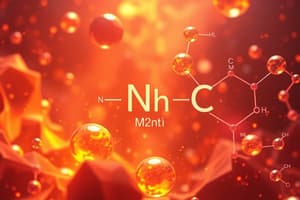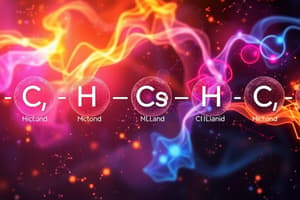Podcast
Questions and Answers
What does the empirical formula of a compound represent?
What does the empirical formula of a compound represent?
- The number of moles of each element in the compound
- The actual ratio of atoms in the compound
- The simplest whole number ratio of atoms of each element (correct)
- The molecular weight of the compound
Which of the following correctly indicates the formula for a compound formed by magnesium and oxygen?
Which of the following correctly indicates the formula for a compound formed by magnesium and oxygen?
- MgO<sub>2</sub>
- MgO<sub>3</sub>
- Mg<sub>2</sub>O
- MgO (correct)
How is the formula for a compound with a non-metal and hydrogen typically constructed?
How is the formula for a compound with a non-metal and hydrogen typically constructed?
- Hydrogen + oxide
- Non-metal + oxide
- Hydrogen + non-metal-ide (correct)
- Non-metal + hydroxide
What is the correct balanced equation for the reaction of sodium hydroxide with hydrochloric acid?
What is the correct balanced equation for the reaction of sodium hydroxide with hydrochloric acid?
What is the structural formula for ammonia?
What is the structural formula for ammonia?
Which of the following represents a correct example of a sulfate compound?
Which of the following represents a correct example of a sulfate compound?
What is the purpose of the valency table provided?
What is the purpose of the valency table provided?
What is the correct state symbol for a gaseous compound in a chemical equation?
What is the correct state symbol for a gaseous compound in a chemical equation?
Flashcards
Empirical Formula
Empirical Formula
The simplest whole number ratio of atoms in a compound.
Molecular Formula
Molecular Formula
The actual number of atoms of each element in a compound.
Metal + Nonmetal Compound Naming
Metal + Nonmetal Compound Naming
Metal name + nonmetal name + -ide.
Nonmetal + Nonmetal Compound Naming
Nonmetal + Nonmetal Compound Naming
Signup and view all the flashcards
Chemical Formula Ratio
Chemical Formula Ratio
Signup and view all the flashcards
Balanced Chemical Equation
Balanced Chemical Equation
Signup and view all the flashcards
State Symbols
State Symbols
Signup and view all the flashcards
Diatomic Molecules
Diatomic Molecules
Signup and view all the flashcards
Study Notes
Compound Names and Formulas
- Empirical Formula: Simplest whole-number ratio of atoms in a compound.
- Molecular Formula: Actual number of each type of atom in a compound.
Forming Compound Names
- Metal + Nonmetal: Metal name + nonmetal name + "-ide" (e.g., magnesium oxide)
- Exceptions (Nonmetal + Nonmetal): Consider the exception of lower-group number nonmetals and hydrogen when naming these compounds (e.g., carbon dioxide = CO2)
Chemical Formulas
- Formula Unit: Smallest unit of a compound with the correct ratio of atoms.
- Structural Formula: Shows how atoms are bonded.
- Water (H₂O): Contains 2 hydrogen atoms and 1 oxygen atom.
- Ammonia (NH₃): Contains 1 nitrogen atom and 3 hydrogen atoms.
Determining Formulas
- Valency/Combining Power: Used to determine the subscripts in the formula..
- Example: Al (3+) and S(2-) combine to create Al₂S₃.
- Balancing Equations: Ensure "equal no. of each atom on either side of the arrow".
Chemical Equations
- State Symbols: Key symbols (s) - solid; (l) - liquid; (g) - gas; (aq) - aqueous.
Studying That Suits You
Use AI to generate personalized quizzes and flashcards to suit your learning preferences.




